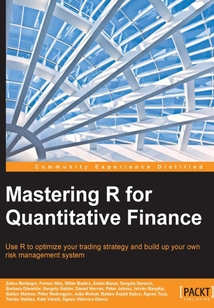舉報 

會員
Mastering R for Quantitative Finance
最新章節:
Index
ThisbookisintendedforthosewhowanttolearnhowtouseR'scapabilitiestobuildmodelsinquantitativefinanceatamoreadvancedlevel.Ifyouwishtoperfectlytakeuptherhythmofthechapters,youneedtobeatanintermediatelevelinquantitativefinanceandyoualsoneedtohaveareasonableknowledgeofR.
目錄(111章)
倒序
- coverpage
- Mastering R for Quantitative Finance
- Credits
- About the Authors
- About the Reviewers
- www.PacktPub.com
- Support files eBooks discount offers and more
- Preface
- What this book covers
- What you need for this book
- Who this book is for
- Conventions
- Reader feedback
- Customer support
- Chapter 1. Time Series Analysis
- Multivariate time series analysis
- Volatility modeling
- Summary
- References and reading list
- Chapter 2. Factor Models
- Arbitrage pricing theory
- Modeling in R
- Summary
- References
- Chapter 3. Forecasting Volume
- Motivation
- The intensity of trading
- The volume forecasting model
- Implementation in R
- Summary
- References
- Chapter 4. Big Data – Advanced Analytics
- Getting data from open sources
- Introduction to big data analysis in R
- K-means clustering on big data
- Big data linear regression analysis
- Summary
- References
- Chapter 5. FX Derivatives
- Terminology and notations
- Currency options
- Exchange options
- Quanto options
- Summary
- References
- Chapter 6. Interest Rate Derivatives and Models
- The Black model
- The Vasicek model
- The Cox-Ingersoll-Ross model
- Parameter estimation of interest rate models
- Using the SMFI5 package
- Summary
- References
- Chapter 7. Exotic Options
- A general pricing approach
- The role of dynamic hedging
- How R can help a lot
- A glance beyond vanillas
- Greeks – the link back to the vanilla world
- Pricing the Double-no-touch option
- Another way to price the Double-no-touch option
- The life of a Double-no-touch option – a simulation
- Exotic options embedded in structured products
- Summary
- References
- Chapter 8. Optimal Hedging
- Hedging of derivatives
- Hedging in the presence of transaction costs
- Further extensions
- Summary
- References
- Chapter 9. Fundamental Analysis
- The basics of fundamental analysis
- Collecting data
- Revealing connections
- Including multiple variables
- Separating investment targets
- Setting classification rules
- Backtesting
- Industry-specific investment
- Summary
- References
- Chapter 10. Technical Analysis Neural Networks and Logoptimal Portfolios
- Market efficiency
- Technical analysis
- Neural networks
- Logoptimal portfolios
- Summary
- References
- Chapter 11. Asset and Liability Management
- Data preparation
- Interest rate risk measurement
- Liquidity risk measurement
- Modeling non-maturity deposits
- Summary
- References
- Chapter 12. Capital Adequacy
- Principles of the Basel Accords
- Risk measures
- Risk categories
- Summary
- References
- Chapter 13. Systemic Risks
- Systemic risk in a nutshell
- The dataset used in our examples
- Core-periphery decomposition
- The simulation method
- Possible interpretations and suggestions
- Summary
- References
- Index 更新時間:2021-07-23 20:11:08
推薦閱讀
- LabVIEW 2018 虛擬儀器程序設計
- Python快樂編程:人工智能深度學習基礎
- TypeScript Blueprints
- 機器學習系統:設計和實現
- MongoDB for Java Developers
- 青少年Python編程入門
- 微信小程序項目開發實戰
- The Complete Coding Interview Guide in Java
- .NET 3.5編程
- 運用后端技術處理業務邏輯(藍橋杯軟件大賽培訓教材-Java方向)
- Linux C編程:一站式學習
- 區塊鏈技術進階與實戰(第2版)
- 軟件測試綜合技術
- RubyMotion iOS Develoment Essentials
- Practical Predictive Analytics
- Learning Unreal Engine Game Development
- ASP.NET Core 2 High Performance(Second Edition)
- Switching to Angular 2
- Learning Unity Physics
- C#面向對象程序設計(微課版)
- Zend Framework 2.0 by Example:Beginner’s Guide
- 思維訓練啟蒙新觀念:青少年Pascal語言編程搶先起跑一路通
- Scratch尋寶之旅
- Java Web動態網站開發(微課版)
- Advanced JavaScript
- 小團隊構建大網站:中小研發團隊架構實踐
- Instant Sikuli Test Automation
- Scratch 3.0少兒游戲趣味編程2
- Node.js Blueprints
- 玩轉Django 2.0

